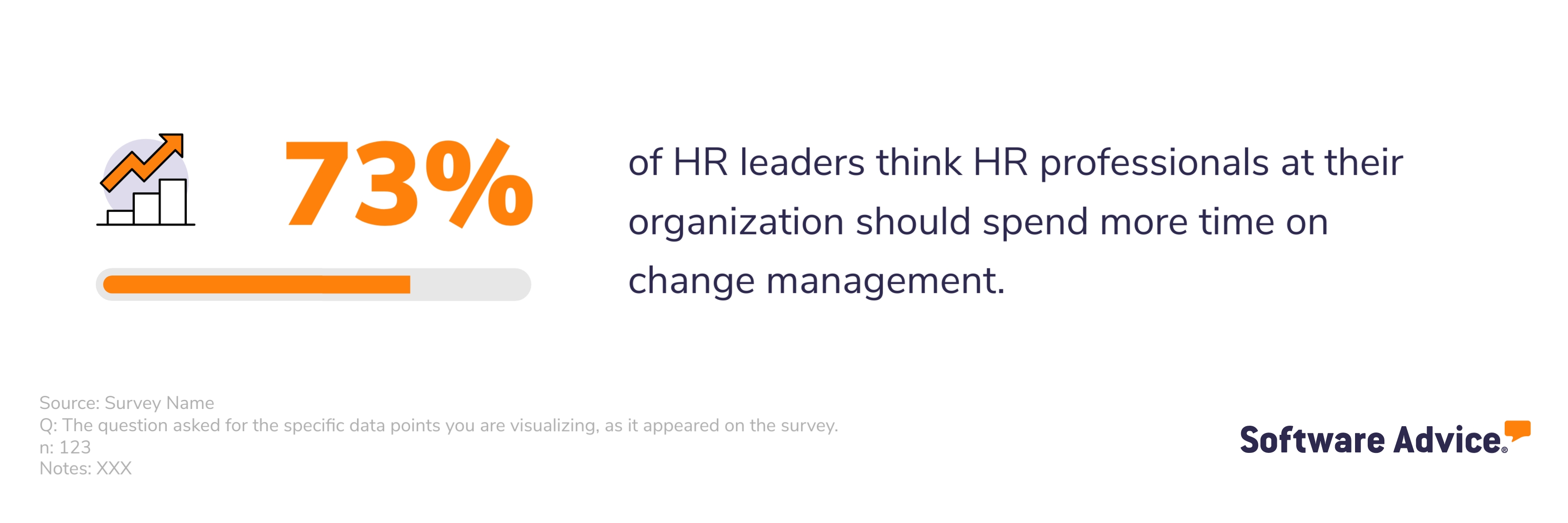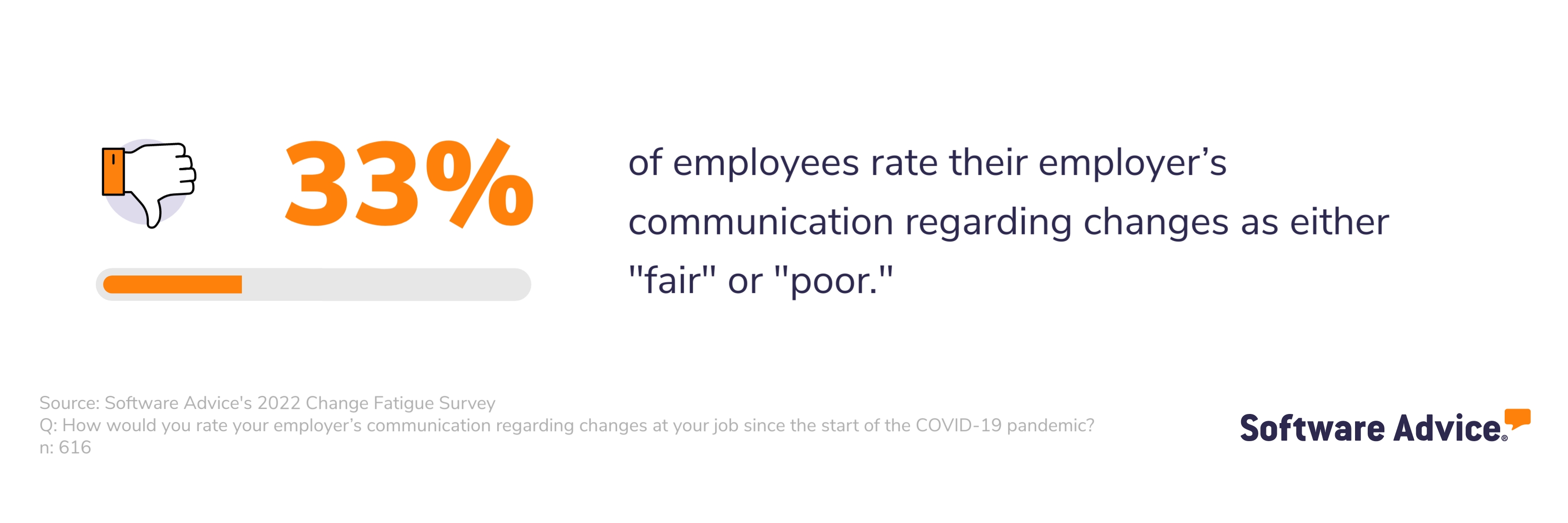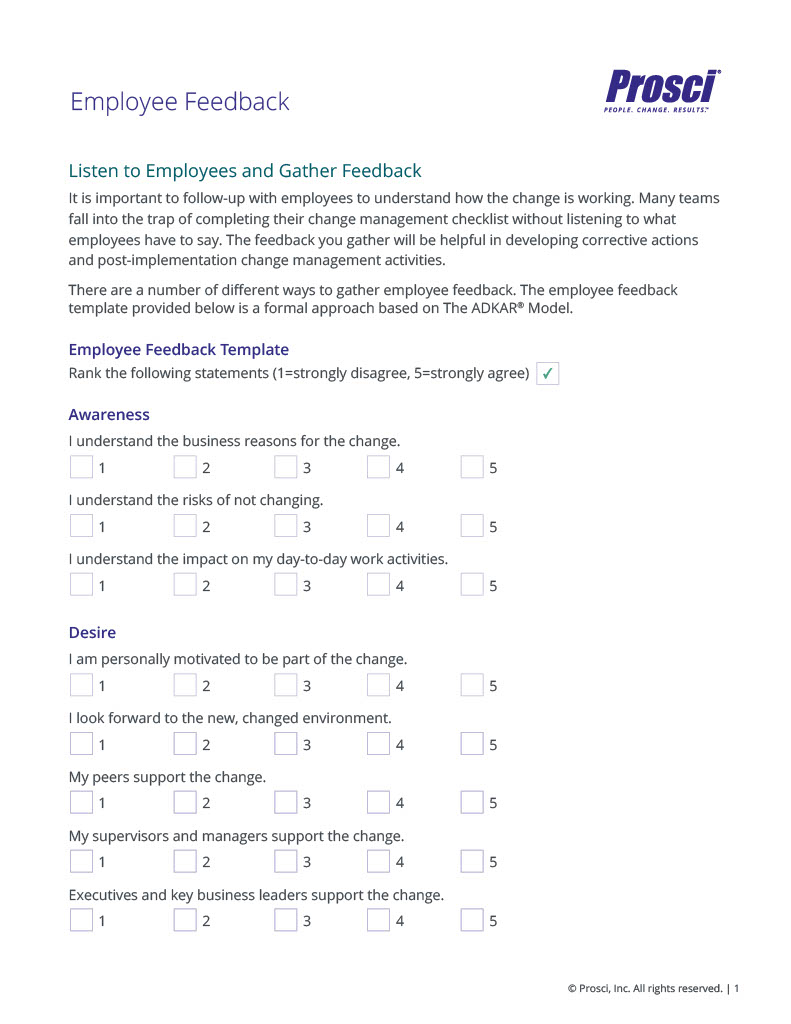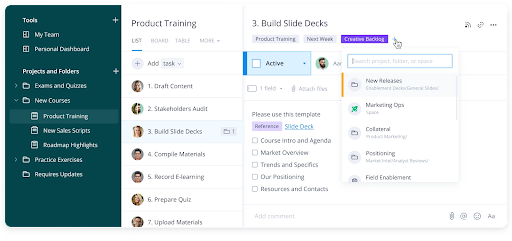What Is The ADKAR Change Management Model?
In 2022, only 39% of HR leaders agreed that their most recent change performed well against goals [1]. This, along with the fact that the barrage of constant change today’s organizations face isn’t going to stop anytime soon, has pushed HR leaders to realize that effectively managing change is becoming an increasingly important component of their role [2].

Whether you’re an HR leader or a project manager, educating yourself on the various change management tactics out there is the first step to take to improve your organization’s change adoption rate and reduce your employees’ change fatigue.
In an effort to help you do that, we’ve analyzed research from Gartner and Software Advice’s own Change Fatigue survey*. Ahead, we’ll break down everything you need to know about the ADKAR change management model, from what it is and how it works to the benefits of using it and what you need to get started with this strategy.
Interested in learning about alternatives to ADKAR? Check out: What Is A Change Management Plan?
What is the ADKAR change management model?
The ADKAR model of change management was developed by Jeff Hiatt, founder of Prosci and former Bell Labs engineer and program manager [3]. Hiatt studied the change patterns of more than 700 organizations to develop the ADKAR model. Today, thousands of change leaders around the world use the ADKAR model.
ADKAR is an acronym that stands for…
A: Awareness of the need for the change
D: Desire to participate and support the change
K: Knowledge of how to change
A: Ability to implement desired skills and behavior
R: Reinforcement to sustain the change
Prosci explains the five building blocks of their ADKAR model [4]
What is the difference between the ADKAR change management model and the PCT model?
The PCT model is another Prosci-founded change management approach. Whereas the PCT model is a framework for organizational change, the ADKAR model focuses on individual change.
About 67% of employees do not understand their role when a change initiative is launched [5]. This is part of why the ADKAR model is so effective—it’s a “bottom-up” approach that focuses on supporting and enabling change at the individual level.
Tim Creasey, chief innovation officer at Prosci, explains the ADKAR model as the five building blocks of successful change for an individual. He says:
Tim Creasey
What are the benefits of using the ADKAR change management model?
It enables change from the bottom up
Top-down approaches are outdated and ineffective in today’s work environment; in fact, only a little over a third (34%) of top-down change initiatives meet their defined goals. Even so, it’s still the most frequently used change management approach. In a Gartner survey, 68% of HR leaders indicated their organization uses the top-down approach to change [5].
The ADKAR model is a bottom-up (or “open-source”) approach that focuses on guiding individuals through a particular change and addressing any roadblocks they might experience along the way. There’s evidence that points to the fact that organizations benefit from adopting strategies like ADKAR.
For example, a bottom-up approach [5]:
Reduces implementation time by up to one-third
Increases employees’ intent to stay by up to 46%
Increases the probability of carrying out a successful change by up to 24%
Increases employee engagement by up to 38%
To quote Tim Creasey:
Tim Creasey
It provides a structured approach to change
As Benjamin Franklin once said, “If you fail to plan, you are planning to fail.”
Taking a step-by-step, structured approach to change is a must. Similar to how SMART goals keep a project moving in the right direction on a pre-established timeline, the ADKAR approach ensures that you define the intended outcome and the steps that have to be taken to get there well ahead of implementation.

The consequences of a poorly planned organizational change are difficult to ignore. For starters, there’s the risk of change fatigue—a form of employee burnout that’s described as apathy or passive resignation toward organizational changes. On its own, change fatigue can cost you: Our survey revealed that 54% of change-fatigued employees are considering looking for a new job*.
But aside from change fatigue, failing to appropriately plan for a change can lead to:
Implementation delays
Missed project milestones
Budget overruns
Rework or duplicated effort from effected teams
Productivity plunges
Lastly, research shows applying a structured approach contributes to success. Prosci revealed that 59% of organizations that applied a particular change management methodology achieved good or excellent levels of change management effectiveness. By contrast, only 26% of organizations achieved the same levels of effectiveness without a structured approach [6].
It’s proven to be successful
As the product of research conducted on hundreds of organizations, the ADKAR model is a tried-and-tested approach to change management. Many businesses have used it to great success, which bodes well for your organization.
Take for example SURA Asset Management, a Latin American financial services leader who found themselves tackling several large projects simultaneously back in 2014 [7]. Those projects included:
A digital transformation in the pensions department
A company-wide innovation initiative
A product sales strategy revamp
A flex office project
In order to navigate the immense amount of change facing their organization, SURA implemented a strategy in the company’s innovation initiative for building awareness and desire—the first two steps in the ADKAR model.
SURA’s CEO and vice president of HR led executive sessions and workshops where sponsors discussed what innovation is and why leaders should want to participate in the initiative. By the end of the six sessions, they had an impressive 300 collaborators engaging with the initiative.
Obviously, much has changed since 2014 in the way of technology and work culture. In the last three years alone, 80% of strategists report carrying out more firm-wide initiatives, with 79% planning a full-scale business model transformation [5]. This proves that the pace of change is only escalating—meaning, SURA’s success with the ADKAR model is just as relevant today if not more so.
How can organizations prepare to adopt the ADKAR model of change management?
1. Get executives on board
Research suggests that employees respond best to messages sent by an executive or senior leader [8]:

Considering the influence executive leaders possess when it comes to organizational communications, we suggest recruiting a C-suite employee to actively support the transition to the ADKAR change management model. This person’s role will be to understand and implement the ADKAR model, as well as oversee any future organizational initiatives where the ADKAR model is put into action.
2. Encourage managers to recognize and support their team members’ needs
At the core of the ADKAR model is the idea that change happens one person at a time. And because people managers often have the best rapport with frontline employees, it’s up to them to identify and address resistance to change among their team members.
In order to build desire (the second ADKAR principle), managers should ask employees what personal motivators would cause them to support the change at hand. They can do this in one-one-one conversations, team meetings, or through surveys.

A survey template from Prosci that can be used to gather employee feedback [8]
3. Ensure you have the resources and software necessary for success
Eighty-three percent of workers suffering from change fatigue say their employer has not provided enough tools or resources to help them adapt*.
Navigating a change without project management or collaboration software is difficult. These tools are useful for tracking individual and team progress toward goals, but they also improve communication and transparency as well.

Learning management systems and employee training software can also be used to deliver instructions to employees affected by a change initiative—the “Knowledge” phase of ADKAR.
Further, if you are adopting the ADKAR model, Prosci offers free eBooks and templates to help you succeed in doing so [10]. We suggest downloading these resources and sharing them with change leaders and sponsors within your organization.
There are more change management models to learn about
It’s clear why today’s HR leaders are seeking frameworks for change management: In late 2022, Gartner projected that the number of disruptions and organization-wide transformations in 2023 would be almost five times the amount that happened back in 2014.
The ADKAR model is a unique approach that’s proven to be successful for all kinds of organizations. If you think this change management model is right for you, we recommend familiarizing yourself with Prosci’s offerings in order to make a business case for the ADKAR model you can present to senior management.
And if you’re not convinced this is the right strategy for your organization, there are more change management models out there to consider. And on that note, check out our related content: What Is A Change Management Plan?
Survey methodology
*Software Advice’s 2022 Change Fatigue Survey was conducted in March 2022 among 970 U.S. employees representative of the U.S. workforce by age, race, and gender. Respondents had to be with the same employer since the start of the COVID-19 pandemic. The goal of this survey was to learn how employees have responded to changes at their job over the course of the pandemic.
Sources
Organization Design and Change Management Primer for 2023, Gartner
3 HRBP Best Practices for Successful Change Management, Gartner
About Prosci | Change Management Research, Training and Solutions, Prosci
Succeeding at Change Management With an Open-Source Approach, Gartner
Employee Feedback Template, Prosci
Note: The screenshots of applications included in this article are examples to show a feature in context and are not intended as endorsements or recommendations.